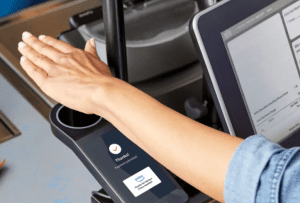Hands Free ? – no, not really

There are many uses for biometric security measures, using scanners that recognize a person’s fingerprints, thumbprints, and iris, for example. Hand-held wands and full body scanners are quite commonplace in airports, and other locations where security is important for detecting and mitigating risk. Most of us accept the need for this technology, even though it may seem somewhat invasive. We live in a world where threats are more common, and most people are willing to give up an ounce of privacy to gain a pound of security. Biometric scanning technology has advanced a great deal in recent years, but can scanning technology do more than detect risk or provide secure access to a facility? Amazon thinks it can.
In 2019 Amazon developed a patented scanning technology that takes biometrics in another direction, where your palm serves as your credit card. The original scan of your palm, saved on a secure Amazon cloud server, becomes your verification for purchases on your Amazon credit account. The scan apparently includes many details of your palm, such as lines, creases, veins, bones and other structural features beneath the skin. The Amazon palm scan is proprietary and patented, so deep dive technical details are not available. Amazon is now testing the system in a Whole Foods store in Seattle, after successful use in several Amazon Go stores last year. This new payment system is named AMAZON ONE.
The union representing many Amazon workers claims that this technology is another way for Amazon to eliminate jobs, so job security is part of the discussion, but so is system security. Experts in cyber security point out some of the risks inherent with this system. First is the security of the cloud server, as a hack of the server could expose your palm scan, and lead to that scan being stolen and used nefariously. Other credit verification systems use “replaceable” items, so that if the item is ever compromised it can be replaced. For example, if your credit card is compromised, the card provider will cancel the compromised card and issue a new card with all new numbers, and most providers will guarantee no loss to you if the card is lost, stolen, or otherwise compromised. That’s a very solid system, but what can be done about a compromised palm print? Probably not much, seeing as we all want to keep our palms right where they are – no one is going to easily issue a new one for you. We all know about book and movie plots where thumbs, fingers, and eyes are “removed” from their owner in order to gain access to a facility secured with biometric scanners. The plots might get a little more bizarre now that palm scans are in the mix.
There are two main drivers for the Amazon One system – convenience, and the perceived need for contact-less purchase verification during a pandemic. The palm reader works by hovering your hand over the reader without touching anything, which meets the need for “no contact”. On the convenience side, this technology allows the customer to make a purchase, on credit, without carrying a credit card, or a wallet or purse to carry it in. We expect the “technology for the sake of convenience” debate to scale up a bit more, now with Amazon One to illustrate a point.
The aim of TREND DISRUPTORS is to discover, explore, and monitor scientific and technical developments, looking for the best and brightest ideas, so that we can publish useful, actionable, investment recommendations for our subscribers. These kinds of recommendations are speculative, and we advise caution, discretion, and thorough research. TREND DISRUPTORS strives to identify investment opportunities that can lead to success for the well informed investor. Stay tuned !
